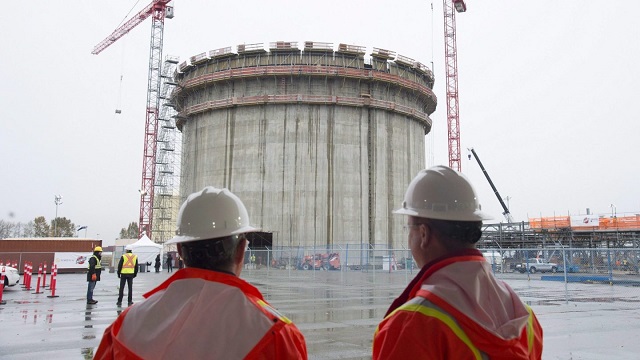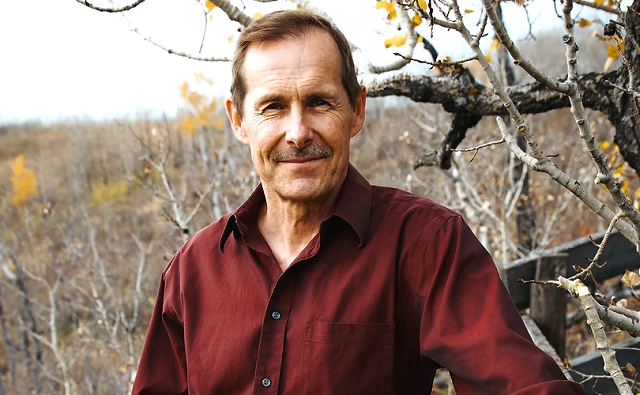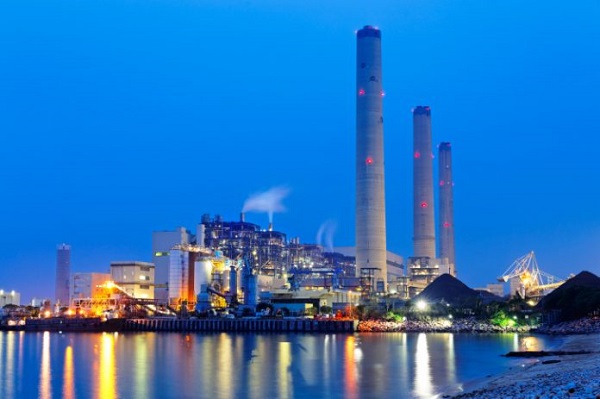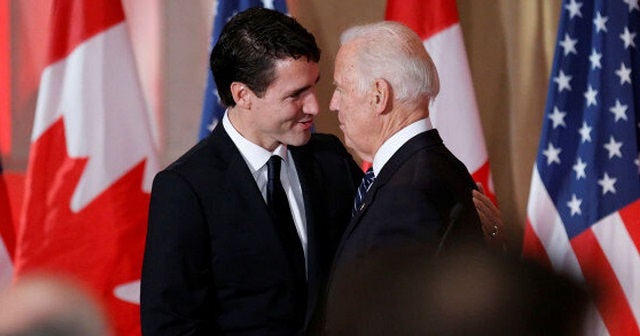Canadian Energy Centre
These three Indigenous women are leading the future of Canadian LNG

Crystal Smith, chief councillor of the Haisla Nation, Karen Ogen, CEO of the First Nations LNG Alliance, and Eva Clayton, president of the Nisga’a Nation.
From the Canadian Energy Centre
‘By being owners in these projects, we can meaningfully contribute to a cleaner and more just world’
Three female Indigenous leaders in British Columbia are leading the future of Canadian LNG.
Eva Clayton is president of the Nisga’a Nation, a joint venture partner in the proposed Ksi Lisims LNG project. Karen Ogen, former elected chief of the Wet’suwet’en First Nation, is CEO of the First Nations LNG Alliance. And Crystal Smith is elected chief of the Haisla Nation, majority owner of the proposed Cedar LNG project, which is in the final stages of preparing for the green light to proceed.
“By being owners in these projects, we can meaningfully contribute to a cleaner and more just world,” said Smith, who was first elected chief of the coastal nation in 2017, during the B.C. Natural Resources Forum earlier this year.
“From an Indigenous perspective, we’re continuously taught to take care of our environment, to take care of our land, and to take only what is required. To think in a global context, I truly believe that in supporting the LNG industry, we are in fact doing that.”

Eva Clayton, back left, President of the Nisga’a Lisims Government (joint venture owner of the proposed Ksi Lisims LNG project), Crystal Smith, back right, Haisla Nation Chief Councillor (joint venture owner of proposed Cedar LNG project), and Karen Ogen, front right, CEO of the First Nations LNG Alliance pose for a photograph on the HaiSea Wamis zero-emission tugboat outside the LNG2023 conference, in Vancouver, B.C., Monday, July 10, 2023. CP Images photo
The global liquefied natural gas industry is rising in importance as emerging economies in Asia look to move away from coal-fired power and European nations reduce reliance on Russia
In 2023, LNG demand reached a record 404 million tonnes, according to Shell’s latest industry outlook. Over the next two decades it is expected to rise by nearly 70 per cent, reaching 685 million tonnes by 2040.
Canada’s first LNG export terminal – located on Haisla territory – is nearing completion and preparing for startup next year.
Smith said the nation has seen great benefits from its support of the LNG Canada project, but owning Cedar LNG with partner Pembina Pipeline Corporation takes the opportunity to a new level.
“We have a bigger vision that provides better education, better health care, better justice, and a better future for our people,” she said.
“We can train our people with the skills needed to secure well-paying, family supporting jobs on Cedar LNG and other projects. We can build critical community infrastructure like our new health center and our youth center in Haisla territory.”
Smith said LNG is helping fund programs that reconnect Haisla people with their culture and language, “a language that virtually disappeared with my generation.”
“We are reigniting our potential through culture and language. And that is perhaps the most powerful thing of all. When I think of my daughter speaking Haisla with my grandchildren, that is what drives me each and every day.”
To the north in the Nass Valley, near B.C.’s border with Alaska, Clayton said the Nisga’a Nation is also using its partnerships in LNG to reconnect with language and culture.
The community owns Ksi Lisims along with Rockies LNG (a coalition of Canadian natural gas producers) and Texas-based developer Western LNG.

Construction of the LNG Canada export terminal is now more than 90 per cent complete. Photo courtesy LNG Canada
“The cultural benefits for the Nisga’a Nation will only be more enhanced as we move forward with the project,” said Clayton, who was first elected president of the community in 2016.
“There are ongoing programs that are in place so that our people and our young people will continue to speak the language. What I’ve noticed is that many of our elders that have been teaching this language are aging out. And so now we see a new generation of young people coming up to speak the language and teach language.”
In B.C.’s central interior, the Wet’suwet’en Nation is facing a loss of culture and language, Ogen said. It’s a situation that can be helped with the economic opportunities of LNG.
“We’re at a place in our community since the pandemic where we have maybe one or two fluent speakers left. That’s really not good news,” said Ogen, who served as chief from 2010 to 2016.
“We want to be able to promote our language in our community and continue promoting our culture in our community because we have very few people in my generation that have traditional names.”
Partnering in development projects like the recently completed Coastal GasLink pipeline (which will supply natural gas to the LNG Canada terminal as well as Cedar LNG) helps communities with access to clean drinking water, housing, health, wellness and education, Ogen said.
She helped found the First Nations LNG Alliance in 2015 with the goal to educate communities about the potential benefits of development.

As construction on Coastal GasLink winds down, crews are working to cleanup and reclaim the land. Clay and topsoil removed during construction has been stored on site and will now be used to contour the land to its previous shape to re-establish original drainage patterns. Photo courtesy Coastal GasLink
“I’ve learned a lot in this job. Being a girl from the rez, being a social worker, and then getting into this field, it’s something I didn’t aspire to. But for me, I’m passionate about it because of what it means to our people on the ground,” she said.
Ogen has shared that message internationally, including during a trade mission to China last fall. The smog from burning coal in Beijing heightened her conviction about the benefits of Canadian LNG in Asia, she said.
“We were given a presentation on how China still wants B.C.’s natural resources; they still want our LNG,” Ogen said.
“B.C. and Canada need to hear those loud messages because we’re at an economic opportunity that’ll help us address the greenhouse gas emissions globally.”
Clayton said she has heard the same thing.
“The messaging that I get from the international world is that they need our LNG. The Germans, Japanese, all of them are wondering why they’re not getting gas from their allies. We have a responsibility as Canadians to help the world get off of coal,” she said.
“We are working together for the benefit of our children. These major projects, every decision that we make is for the future of our children, the future of Canada, the world really when you think about the kind of industry we’re getting into, LNG.”
Smith’s Cedar LNG could be the first Indigenous-led project in the world. Pembina Pipeline plans to spend up to $300 million advancing it to a final investment decision by mid-year.
“Every time I hear about it, I literally start shaking and getting goosebumps. I’ll have many sleepless nights from now until that decision is made,” Smith said.
“Our nation has had the ability to benefit from LNG development in our territory, but let’s not let it be the last.
“There are so many other LNG projects with indigenous leadership in B.C. that have the potential to make a significant impact on the future of Indigenous people and also help fight climate change.”
Alberta
Game changer: Trans Mountain pipeline expansion complete and starting to flow Canada’s oil to the world

Workers complete the “golden weld” of the Trans Mountain pipeline expansion on April 11, 2024 in the Fraser Valley between Hope and Chilliwack, B.C. The project saw mechanical completion on April 30, 2024. Photo courtesy Trans Mountain Corporation
From the Canadian Energy Centre
By Will Gibson
‘We’re going to be moving into a market where buyers are going to be competing to buy Canadian oil’
It is a game changer for Canada that will have ripple effects around the world.
The Trans Mountain pipeline expansion is now complete. And for the first time, global customers can access large volumes of Canadian oil, with the benefits flowing to Canada’s economy and Indigenous communities.
“We’re going to be moving into a market where buyers are going to be competing to buy Canadian oil,” BMO Capital Markets director Randy Ollenberger said recently, adding this is expected to result in a better price for Canadian oil relative to other global benchmarks.
The long-awaited expansion nearly triples capacity on the Trans Mountain system from Edmonton to the West Coast to approximately 890,000 barrels per day. Customers for the first shipments include refiners in China, California and India, according to media reports.
Shippers include all six members of the Pathways Alliance, a group of companies representing 95 per cent of oil sands production that together plan to reduce emissions from operations by 22 megatonnes by 2030 on the way to net zero by 2050.
The first tanker shipment from Trans Mountain’s expanded Westridge Marine Terminal is expected later in May.
 Photo courtesy Trans Mountain Corporation
Photo courtesy Trans Mountain Corporation
The new capacity on the Trans Mountain system comes as demand for Canadian oil from markets outside the United States is on the rise.
According to the Canada Energy Regulator, exports to destinations beyond the U.S. have averaged a record 267,000 barrels per day so far this year, up from about 130,000 barrels per day in 2020 and 33,000 barrels per day in 2017.
“Oil demand globally continues to go up,” said Phil Skolnick, New York-based oil market analyst with Eight Capital.
“Both India and China are looking to add millions of barrels a day of refining capacity through 2030.”
In India, refining demand will increase mainly for so-called medium and heavy oil like what is produced in Canada, he said.
“That’s where TMX is the opportunity for Canada, because that’s the route to get to India.”
Led by India and China, oil demand in the Asia-Pacific region is projected to increase from 36 million barrels per day in 2022 to 52 million barrels per day in 2050, according to the U.S. Energy Information Administration.
More oil coming from Canada will shake up markets for similar world oil streams including from Russia, Ecuador, and Iraq, according to analysts with Rystad Energy and Argus Media.
Expanded exports are expected to improve pricing for Canadian heavy oil, which “have been depressed for many years” in part due to pipeline shortages, according to TD Economics.
 Photo courtesy Trans Mountain Corporation
Photo courtesy Trans Mountain Corporation
In recent years, the price for oil benchmark Western Canadian Select (WCS) has hovered between $18-$20 lower than West Texas Intermediate (WTI) “to reflect these hurdles,” analyst Marc Ercolao wrote in March.
“That spread should narrow as a result of the Trans Mountain completion,” he wrote.
“Looking forward, WCS prices could conservatively close the spread by $3–4/barrel later this year, which will incentivize production and support industry profitability.”
Canada’s Parliamentary Budget Office has said that an increase of US$5 per barrel for Canadian heavy oil would add $6 billion to Canada’s economy over the course of one year.
The Trans Mountain Expansion will leave a lasting economic legacy, according to an impact assessment conducted by Ernst & Young in March 2023.
In addition to $4.9 billion in contracts with Indigenous businesses during construction, the project leaves behind more than $650 million in benefit agreements and $1.2 billion in skills training with Indigenous communities.
Ernst & Young found that between 2024 and 2043, the expanded Trans Mountain system will pay $3.7 billion in wages, generate $9.2 billion in GDP, and pay $2.8 billion in government taxes.
Canadian Energy Centre
North America LNG project cost competitiveness

Construction workers look on at the FortisBC Tilbury LNG expansion project in Delta, B.C., Monday, Nov. 16, 2015. CP Images photo
From the Canadian Energy Centre
Lower costs for natural gas, shipping and liquefaction give Canada an edge in the emerging global LNG market
Worldwide concerns about energy security have put a renewed focus on the international liquefied natural gas (LNG) industry. The global demand for LNG is expected to increase over the next few decades.
Global demand growth will be driven primarily by Asian markets where the need for LNG is expected to increase from 277 million tonnes (MT) in 2025 to 509 MT by 2050 (see Figure 1). By 2050 the demand for LNG in Europe will be 83 MT and in Africa 20 MT. In South America too, demand will increase – from 13 MT in 2025 to 31 MT in 2050.

Source: Derived from Rystad Energy, Gas and LNG Markets Solution.
In North America (Canada, Mexico, and United States) a number of LNG projects that are either under construction or in the planning stages will benefit from the rise in global LNG demand.
North American LNG production is expected to grow from 112 MT in 2025 to over 255 MT by 2050 (see Figure 2). In Canada, the LNG projects under construction or in the planning stages include LNG Canada Phases 1 & 2, Woodfibre LNG, Cedar LNG, the Tilbury LNG expansion, and Ksi Lisims LNG. Canada’s LNG production is expected to grow from just 2 MT in 2025 to over 43 MT by 2050. In the United States production is projected to increase from 108 MT in 2025 to 210 MT in 2050.

Source: Derived from Rystad Energy, Gas and LNG Markets Solution.
This CEC Fact Sheet uses Rystad Energy’s Gas and LNG Markets Solution¹ to benchmark the cost competitiveness of LNG projects that are under construction and proposed in Canada compared to other LNG projects under construction and planned elsewhere in North America. (Note that the content of this report does not represent the views of Rystad Energy.)
The LNG cost competitiveness benchmarking analysis used the following performance metrics:
- LNG plant free-on-board (FOB) cost break-even;
- Total LNG plant cost (for delivery into Asia and Europe).
The objective of this LNG cost competitiveness benchmarking is to compare the competitiveness of Canadian LNG projects against those of major competitors in the United States and Mexico. The selection of other North American LNG facilities for the benchmark comparison with Canadian LNG projects (LNG Canada, the Tilbury LNG Expansion, Woodfibre LNG, Cedar LNG, and Ksi Lisims LNG) is based on the rationale that virtually all Canadian LNG plants are under construction or in the planning stage and that they compare well with other North American LNG plants that are also under construction or are being planned between 2023 and 2050. Further, to assess the cost competitiveness of the various LNG projects more accurately, we chose only North American LNG facilities with sufficient economic data to enable such a comparison. We compared the cost competitiveness of LNG coming from these other North American projects with LNG coming from Canada that is intended to be delivered to markets in Asia and Europe.
1. Rystad Energy is an independent energy research company providing data, analytics, and consultancy services to clients around the globe. Its Gas and LNG Markets Solution provides an overview of LNG markets worldwide. The Solution covers the entire value chain associated with gas and LNG production, country and sector-level demand, and LNG trade flows, infrastructure, economics, costs, and contracts through 2050. It allows for the evaluation of the entire LNG market infrastructure, including future planned projects, as well as the benchmarking of costs for LNG projects (Rystad Energy, 2024).
Comparison of LNG project FOB cost break-even (full cycle)
Figure 3 provides a comparison of the free-on-board (FOB) cost break-even for LNG facilities under construction or being planned in North America. FOB break-even costs include upstream and midstream costs for LNG excluding transportation costs (shipping) as seen from the current year. Break-even prices assume a discount rate of 10 percent and represent the point at which the net present value for an LNG project over a 20- to 30-year period becomes positive, including the payment of capital and operating costs, inclusive of taxes.
Among the selected group of North American LNG projects are Canadian LNG projects with an FOB break-even at the lower end of the range (US$7.18 per thousand cubic feet (kcf)) to those at the higher end (US$8.64 per thousand cubic feet (kcf)).
LNG projects in the United States tend to settle in the middle of the pack, with FOB break-even between US$6.44 per kcf and US$8.37 per kcf.
Mexico LNG projects have the widest variation in costs among the selected group of projects, ranging from US$6.94 per kcf to US$9.44 per kcf (see Figure 3).

Source: Derived from Rystad Energy, Gas and LNG Markets Solution.
Total costs by project for LNG delivery to Asia and Europe
The total cost by LNG plant includes FOB cost break-even, transportation costs, and the regasification tariff. Figure 4 compares total project costs for LNG destined for Asia from selected North American LNG facilities.
Canadian LNG projects are very cost competitive, and those with Asia as their intended market tend to cluster at the lower end of the scale. The costs vary by project, but range between US$8.10 per kcf and US$9.56 per kcf, making Canadian LNG projects among the lowest cost projects in North America.
The costs for Mexico’s LNG projects with Asia as the intended destination for their product tend to cluster in the middle of the pack. Costs among U.S. LNG facilities that plan to send their product to Asia tend to sit at the higher end of the scale, at between US$8.90 and US$10.80 per kcf.

Source: Derived from Rystad Energy, Gas and LNG Markets Solution.
Figure 5 compares total project costs for LNG to be delivered to Europe from select North American LNG facilities.
Costs from U.S. LNG facilities show the widest variation for this market at between US$7.48 per kcf and US$9.42 per kcf, but the majority of U.S. LNG facilities tend to cluster at the lower end of the cost scale, between US$7.48 per kcf and US$8.61 per kcf (see Figure 5).
Canadian projects that intend to deliver LNG to Europe show a variety of costs that tend to cluster at the middle to higher end of the spectrum, ranging from US$9.60 per kcf to and US$11.06 per kcf.
The costs of Mexico’s projects that are aimed at delivering LNG to Europe tend to cluster in the middle of the spectrum (US$9.11 per kcf to US$10.61 per kcf).

Source: Derived from Rystad Energy, Gas and LNG Markets Solution.
Conclusion
LNG markets are complex. Each project is unique and presents its own challenges. The future of Canadian LNG projects depends upon the overall demand and supply in the global LNG market. As the demand for LNG increases in the next decades, the world will be searching for energy security.
The lower liquefaction and shipping costs coupled with the lower cost of the natural gas itself in Western Canada translate into lower prices for Canadian LNG, particularly that destined for Asian markets. Those advantages will help make Canadian LNG very competitive and attractive to markets worldwide.
-

 Alberta2 days ago
Alberta2 days agoCanadian Christian chiropractor fights ‘illegal’ $65,000 fine for refusing to wear mask
-

 Media2 days ago
Media2 days agoCBC tries to hide senior executive bonuses
-

 COVID-192 days ago
COVID-192 days agoCOVID Is Over — But Did We Learn Anything From It?
-

 Energy1 day ago
Energy1 day agoU.S. EPA Unveils Carbon Dioxide Regulations That Could End Coal and Natural Gas Power Generation
-

 John Stossel1 day ago
John Stossel1 day agoThe Swamp Survived: Why Trump Failed to “Drain the Swamp”
-

 Opinion24 hours ago
Opinion24 hours agoBoy Scouts of America changes name to ‘Scouting America’ to be ‘more inclusive’
-

 Fraser Institute2 days ago
Fraser Institute2 days agoTrudeau and Ford should attach personal fortunes to EV corporate welfare
-

 conflict2 days ago
conflict2 days ago‘Got Played’: Israel Reportedly Suspicious Biden Admin Had Backroom Talks With Mediators Over Ceasefire Deal










